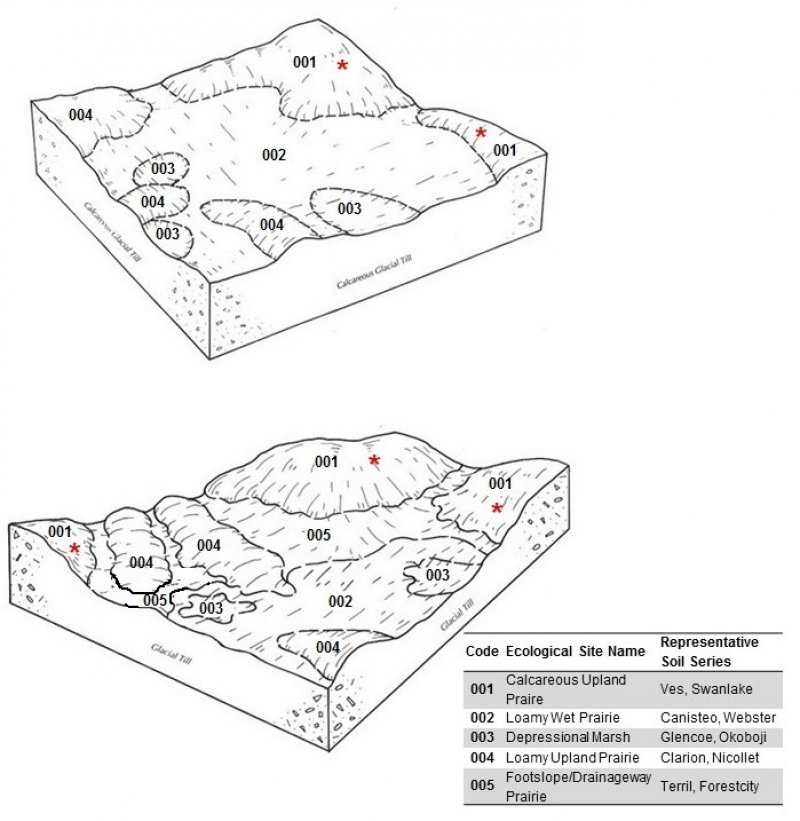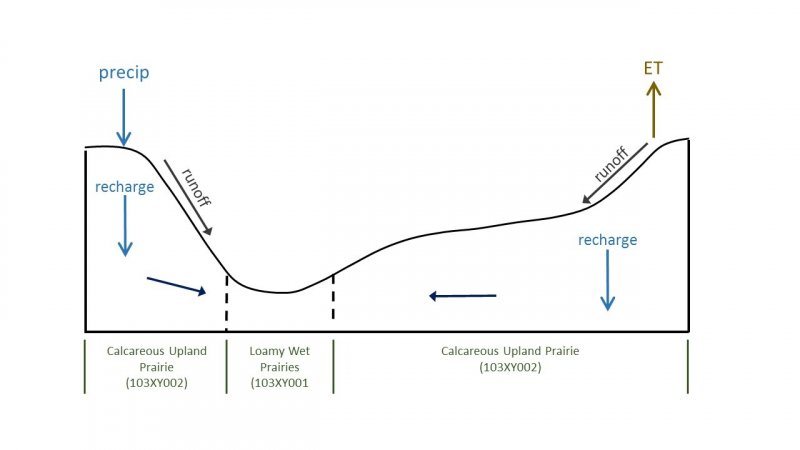Ecological dynamics
The communities within the Reference State are dependent upon the influences of grazing and frequency of fire events. Fire is an important trigger that promotes continued herbaceous vegetation dominance and removes dense thatch thereby allowing for seedling regeneration. Fire also removes plant litter, helps cycle nutrients, and allows light to reach the seedbed. Frequent fire maintains this plant community in a grassland state, by keeping fire-sensitive woody species from proliferating and gaining dominance. A secondary trigger is grazing. Intensive grazing reduces the extent of highly palatable species thereby allowing the growth of less desirable plants to increase.
High-quality, unplowed areas of the Reference State are extremely uncommon today. Most remaining natural areas that are managed for native prairie were once utilized for agricultural production and reseeded. It is therefore likely that many native prairie species are extirpated even from these restored sites.
State 1
Reference State
The reference plant community is native prairie with a diversity of grasses and forbs. Plant community composition is influenced by grazing, drought, and frequency of fire events. Fire is a trigger that promotes continued herbaceous vegetation dominance and removes dense thatch thereby allowing for seedling regeneration. Fire also removes plant litter, helps cycle nutrients, and allows light to reach the seedbed. Areas of this ecological site historically burned every 5 years or less. Frequent fire maintains this plant community in a grassland state, by keeping fire-sensitive woody species from proliferating and gaining dominance.
The secondary trigger for conversion is grazing. Intensive grazing reduces the extent of highly palatable species thereby allowing the growth of less desirable plants to increase. Grazing management guidelines vary by site depending on site specifics and management objectives. Numerous grasses and forbs may grow on this state and the community composition will be determined by fire, drought, and grazing.
High-quality, unplowed areas of the reference state are extremely uncommon today. Most remaining natural areas that are managed for prairie were once utilized for agricultural production. It is therefore likely that many native prairie species are extirpated even from these sites.
Resilience management. Prescribed fire and managed grazing are key resilience management practices. This is a stable plant community when grazing and fire are adequately managed.
Prescribed grazing incorporates periods of grazing rest during the growing season which benefits tallgrass maintenance. Excessive grazing can quickly impact the vegetative composition and negatively impact soil stability.
Prescribed fire is the controlled application of fire to modify vegetation structure and influence ecological processes.
Community 1.1
High Diversity Prairie
This plant community consists of native warm-season grasses and a variety of native forbs. The vegetative composition is influenced primarily by fire return intervals of less than 3 years. Dominant species include little bluestem, leadplant, and an array of native forbs. Frequent fire reduces the extent of woody species and maintains the natural dominance and diversity of native grasses and forbs. A suite of diagnostic herbaceous species is yet to be developed; however, aster (Symphyotrichum spp.), prairie clover (Dalea spp.), blazing star (Liatris spp.), sunflower (Helianthus spp.), and goldenrod (Solidago spp.) are common.
Grazing is a primary trigger on many sites and the intensity and timing of the grazing management practices will control the health, composition, and structure of the vegetative community.
Resilience management. Prescribed fire and managed grazing are key resilience management practices. This is a stable plant community when grazing and fire are adequately managed. Prescribed grazing incorporates periods of grazing rest during the growing season which benefits grass maintenance. Excessive grazing can quickly impact the vegetative composition and negatively impact soil stability and water quality.
Community 1.2
Old Growth Prairie
This community is characterized by a longer fire return interval than that of Community 1.1. Native grasses are still dominant, but more woody species are present. Thatch and dead plant residue are denser than in Community 1.1. Thatch will increase annually. Woody species will increase within the community. Grazing can also greatly influence the composition of this site. Unmanaged grazing has the potential to negatively impact plant composition resulting in a decrease in desired grasses and an increase in undesirable woody species and unpalatable plants.
Resilience management. Prescribed fire and grazing are resilience management practices. Although this community has a longer fire return interval than Community 1.1, it also relies on fire and grazing to maintain vegetation community structure.
Prescribed grazing promotes grass regeneration and vigor. By incorporating periods of pasture rest and recovery during the growing season, landowners can insure that the palatable grasses and forbs are maintained within the community.
Pathway 1.1A
Community 1.1 to 1.2
Fire is the primary trigger that affects the plant community composition. This pathway consists of a fire free period of 3 to 5 years. Secondary triggers include grazing and drought.
Pathway 1.2A
Community 1.2 to 1.1
This pathway consists of a fire return interval of less than 3 years. Fire intolerant woody species are set back, and the amount of dead plant material is reduced.
State 2
Tillage State
Tillage is the primary mechanism affecting the transition to this state. In this state, dynamic soil properties such as bulk density, structure, organic carbon content, and saturated hydraulic conductivity are altered by agricultural practices. Most areas in this state will remain in use for crop production in the foreseeable future – primarily in an intensive corn and soybean rotation. Certain practices can mitigate the impacts of traditional agricultural practices on soil health. Conservation tillage minimizes soil disturbance and can improve soil structure and overall soil health. Corn or soybean plantings and a cover crop rotation can build soil structure, improve infiltration rates, reduce runoff and erosion, and protect water quality.
Some areas in this ecological site are not appropriate for intensive crop production due to slope. Where the gradient exceeds 20 percent row crop production is not feasible due to limitations on farm machinery.
A small percentage of areas have been seeded back to grass. Some previously tilled areas have been converted to warm-season grasslands as part of the NRCS Conservation Reserve Program (CRP). Although highly beneficial to wildlife, these sites generally lack the diversity of species in a high-quality reference state.
Depending on the management objectives of the landowner, cool-season grasses may be planted. Although cool-season grasslands are not as species rich or biologically diverse as warm-season grasslands, they still offer various soil health benefits and some ecological benefits for grassland bird species.
Resilience management. Disturbance management and harvest management are resilience management practices. The maintenance of this state requires that the intensity, frequency, duration, and timing of agricultural practices (disturbances) be managed to control or modify vegetation structure.
Community 2.1
Row Crop Community
This plant community typically consists of intensively produced, traditional row crops. Tillage and intentional plant establishment (crop seeding) are the primary triggers for this community. The most common crops are corn and soybeans on an annual rotation. Conservation practices may be implemented to reduce erosion. These practices can help protect the soil surface from erosion and improve water infiltration. Examples include no-till or ridge-till, which leave residue on the surface of the field. Additional soil health benefits can be gained by adding alternative crops to fields that are already in conservation tillage. By diversifying the crop rotation, landowners take additional management steps to improve soil health and protect water quality.
Resilience management. Disturbance management and harvest management are resilience management practices. The maintenance of the desired vegetation community requires management of the intensity, frequency, duration, and timing of disturbances caused by agricultural practices.
Community 2.2
Seeded Grassland Community
This plant community grows in areas that were previously tilled and used for agricultural production but have been transitioned to either warm-season or cool-season grasses. The primary trigger is the intentional establishment of a grassland community. Warm-season grasses are commonly planted through conservation programs, such as the NRCS Conservation Reserve Program (CRP). Species often include big bluestem, little bluestem, and native forbs that benefit wildlife and pollinators. Seed mix selection depends on landowner objectives and site-specific characteristics.
A small percentage of acres are in cool-season grass species such as Kentucky bluegrass and reed canarygrass. Management inputs include site preparation, seeding, and weed control. Many of these areas are eventually transitioned to annual crop production.
Resilience management. The maintenance of the desired vegetation structure requires management of the intensity, frequency, duration, and timing of disturbances (seeding, weed control, brush control).
Prescribed fire is a resilience management practice on warm-season grasslands. The controlled application of fire modifies vegetation structure and influence ecological processes.
Pathway 2.1.A
Community 2.1 to 2.2
This pathway converts Community 2.1 (row crops) to Community 2.2 (seeded grassland).
The primary mechanism of change is the seeding of desired grass species.
| Forage and Biomass Planting |
|
Pathway 2.2.A
Community 2.2 to 2.1
This pathway converts seeded grassland to cropland. This is a common pathway throughout MLRA 103 as areas are placed in crop production. The mechanisms of change are tillage and intentional plant establishment (crop seeding).
Transition T1A
State 1 to 2
Transition T1A is the conversion of the reference state to agriculture. The triggers are tillage and intentional plant establishment (crop seeding). Resilience management practices include continual agricultural practices such as seeding, fertilizing, and managing invasive plants with herbicides or field cultivation. Hydrological modifications, such as ditching and tiling, may also be installed.
Constraints to recovery. Tillage and long-term intensive agricultural production generally preclude a return to State 1. Areas in row crop production may be placed in conservation programs and seeded with warm-season grasses, but will not exhibit the natural species diversity or ecological resiliency of State 1.



